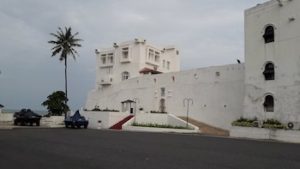
Osu Castle (fort Christiansborg)
*On this date in 1660, the Osu Castle is affirmed. This slave Fort (also known as Fort Christiansborg) is a castle in Osu, Ghana, on the coast of the Gulf of Guinea in Africa.
The facility was built by Denmark-Norway, Portugal, Akwamu, Britain, and finally, post-Independence Ghana. Under Denmark–Norway control, it was the capital of the Danish Gold Coast and held and dispatched enslaved people overseas. The area was first occupied by the Portuguese in 1550, although Portuguese influence diminished in the 17th century. In its early years, the castle was primarily involved in the gold and ivory trade, but under Dano-Norwegian control, it increasingly played a role in the Middle Passage. Osu Castle was located close to two other forts and was controlled by the Dutch, and Fort James by the British. The settlement at Osu was too small to store sufficient goods to compete with the others.
Denmark-Norway purchased adjoining land and expanded the building, naming it Fort Christiansborg after the reigning Danish King Christian V. This is not to be confused with the slightly later royal palace in Copenhagen. Denmark-Norway would occupy the fort for the next 200 years. The Akwamu ethnic group occupied the fort in 1693 after overpowering the occupants (reduced by death and disease) while disguised as merchants. Assameni, the Akwamu leader, occupied the fort for a year, trading with merchants from many nations.
In 1694, Assameni sold the fort back to Denmark-Norway for 50 marks of gold (worth £200,000 to £250,000 in 2008) but retained the keys, which are still in the ethnic group's possession today. The early 18th century was not kind to the fort, and in 1722, the English reported it to be in disrepair. The additional storerooms, garrison quarters, platforms, bastions, and houses resulted in the castle being four times the size of the original fort. In the 1770s, the Danes at Osu became involved in a conflict with the Dutch-controlled Accra. Extensions and structural improvements were made in 1824.
After the British slave trade was abolished in 1850, they purchased all Denmark's Gold Coast possessions for £10,000 (between £850,000 and £1.5m in 2007). Denmark had been considering selling these outposts; they were expensive to run and brought little benefit. Britain experienced the same problems but was keen to prevent illegal slave trading and France or Belgium's strengthening in the area. An earthquake in 1862 destroyed most of the upper floors. Later that century, the castle became the seat of the colonial government.
The British colonial powers abandoned it from 1890 to 1901. Within this period, it was used as a constabulary mess and later as a psychiatric asylum. It became the seat of government again in 1902. In 1950, the wooden upper floors were rebuilt. In 1957, when Ghana gained independence, with Queen Elizabeth II as its head of state, the fort became Government House, the residence of the Governor-General. When Ghana became a republic in 1960, it became the residence of Ghana's first president, Kwame Nkrumah.
In 2005, there was debate over whether Osu Castle should be replaced as the seat of government. President John Kufuor argued that his government should not sit in the castle due to its previous association with slavery and inadequate facilities. National Democratic Congress MPs, however, argued that the $50 m that a new presidential palace would cost would be better spent elsewhere.